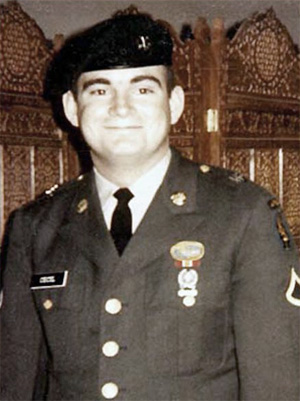Alan Bruce Cecil

Rank/Branch: E5/US Army Special Forces
Unit: CCN – MACV-SOG, 5th Special Forces Group
Date of Birth: 05 September 1946
Home City of Record: Holdenville OK
Date of Loss: 21 September 1969
Country of Loss: Laos
Loss Coordinates: 165104N 1061939E (XD414634)
Status (in 1973): Killed/Body Not Recovered
Category: 2
Aircraft/Vehicle/Ground: Ground
Other Personnel in Incident: (none missing)
REMARKS:
Source: Compiled from one or more of the following: raw data from U.S. Government agency sources, correspondence with POW/MIA families, published sources, interviews. Updated by the P.O.W. NETWORK in 2020.
SYNOPSIS: SP5 Alan B. Cecil was a rifleman assigned from 5th Special Forces to Command and Control North (CCN), MACV-SOG (Military Assistance Command, Vietnam Studies and Observation Group). MACV-SOG was a joint service high command unconventional warfare task force engaged in highly classified operations throughout Southeast Asia. The 5th Special Forces channeled personnel into MACV-SOG (although it was not a Special Forces group) through Special Operations Augmentation (SOA), which provided their “cover” while
under secret orders to MACV-SOG. The teams performed deep penetration missions of strategic reconnaissance and interdiction which were called, depending on the time frame, “Shining Brass” or “Prairie Fire” missions.
On September 21, 1969, Cecil’s team had been inserted into Laos about 20 miles west of the Demilitarized Zone (DMZ) on a reconnaissance mission. The region was heavily travelled by the enemy, moving troops and equipment along the famed “Ho Chi Minh Trail”.
Cecil’s team engaged a numerically superior force, and in the initial burst of fire, the team leader was wounded and SP5 Cecil and one indigenous team member were killed. Cecil was hit in the head, and the remaining team later reported that SP5 Cecil was no longer breathing. The team leader and one remaining indigenous team member were able to escape and evade and were eventually extracted safely that night, leaving Cecil’s body behind.
Because of the enemy concentration in the area, no search or later extraction was possible. For every insertion like Cecil’s that was detected and stopped, dozens of other commando teams safely slipped past NVA lines to strike a wide range of targets and collect vital information. The number of MACV-SOG missions conducted with Special Forces reconnaissance teams into Laos and Cambodia was 452 in 1969. It was the most sustained American campaign of raiding, sabotage and intelligence-gathering waged on foreign soil in U.S. military history.
MACV-SOG’s teams earned a global reputation as one of the most combat effective deep-penetration forces ever raised.

